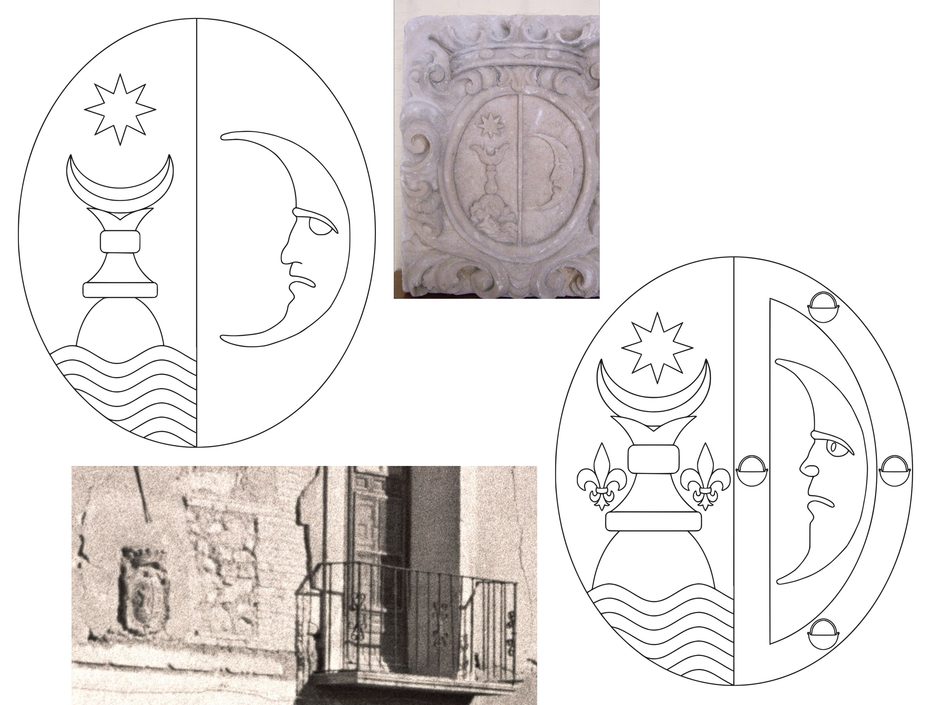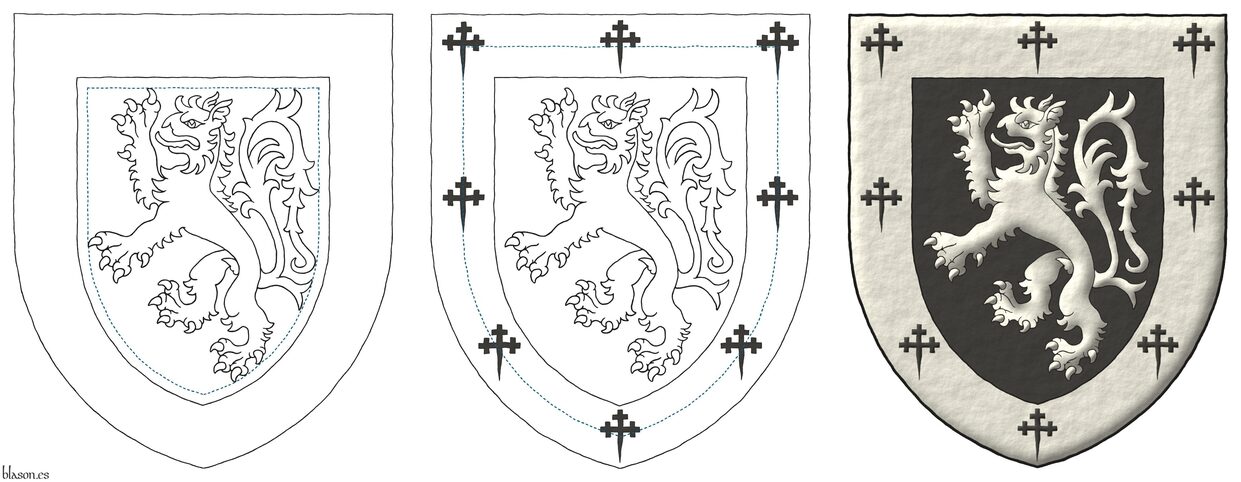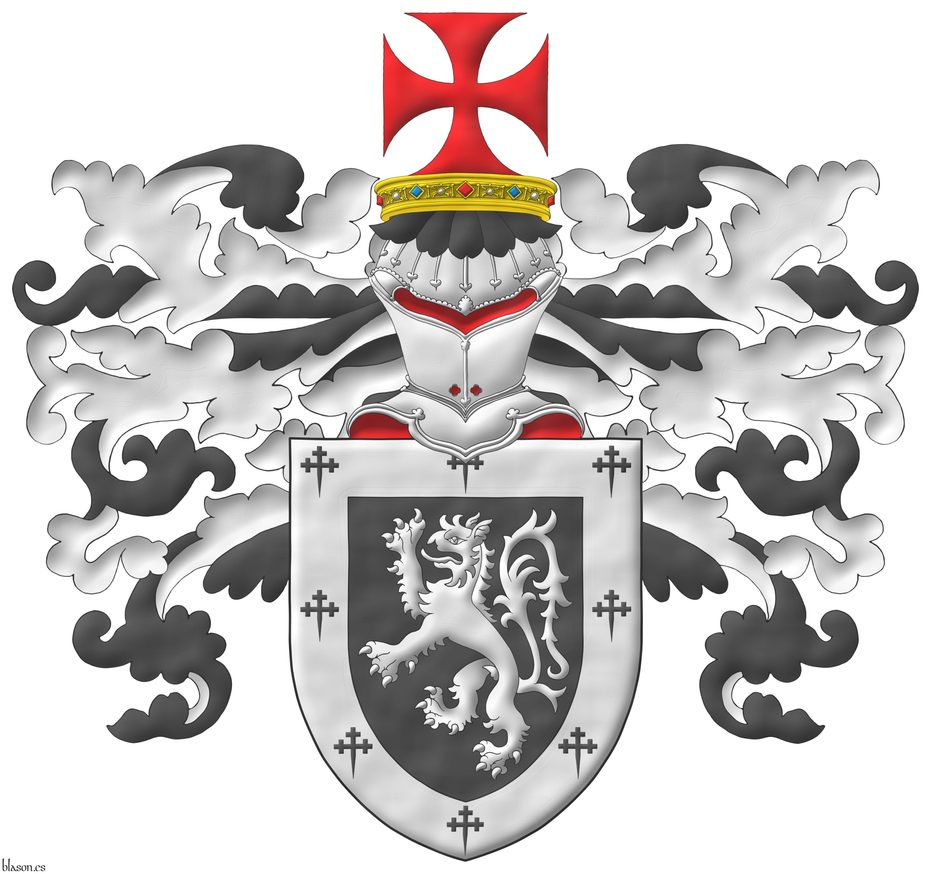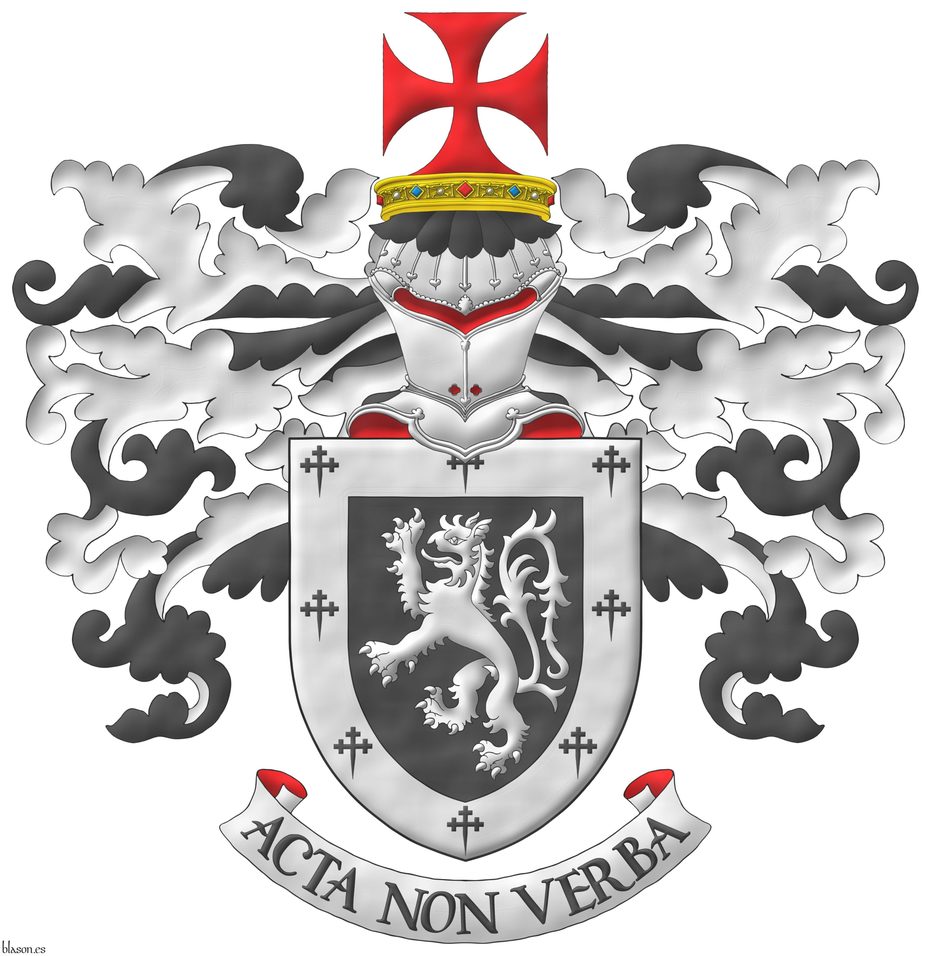
The Administration House of the Pious Foundations of Cardinal Belluga y Moncada
Conference by Francisco Domingo Larrosa Gil, «The Administration House of the Pious Foundations of Cardinal Belluga y Moncada in the Town o f Dolores», sponsored by the University of Alicante, Archbishop Loazes Chair, Orihuela University Venue, coordinated by Dr. Gregorio Canales Martínez, Academic Coordinator of the Chair.
The main objective of the conference was to analyze and identify the coats of arms present on the façade of the former Administration House of the Pious Foundations of Cardinal Belluga y Moncada, located in the town of Dolores, Alicante. Through a historical and heraldic approach, the evolution of the property and changes in its ownership were detailed. Initially, the arms of the first Count of Pinohermoso, Juan Nepomuceno Mariano Roca de Togores y Escorcia, 1752–1794, who acquired the building after its disentailment, were identified. His coat of arms, featuring the cross of the Order of Malta, confirms his connection to this order as a Knight of the Sovereign Military and Hospitaller Order of St. John of Jerusalem, Rhodes, and Malta. This emblem does not appear in subsequent armorial bearings of holders of this title, securing its identification as belonging to the building's first noble owner. The transition of the property from its original association with Cardinal Belluga y Moncada to the House of the Marquisate of Rafal was then highlighted, possibly acquired by Antonia María de Heredia y Rocamora, 8th Marchioness of Rafal, or her son, Vicente Melo de Portugal y Heredia, 9th Marquis of Rafal, between the late 18th and early 19th centuries. Subsequently, the property was sold in 1927 to a merchant known as Don Juan del Arroz and, finally, demolished in 1960.
In the image, two photos of armorial stones from the Roca-Togores lineage and two delineations made by me, extracted from these armorial stones, which were presented during the conference.


Lord of South Clifton, schema 1x3
Sable, a tyger rampant Argent; a bordure Argent charged with eight crosses crosslet fitchy Sable.
Coat of arms of the Lord of South Clifton emblazoned by me in 3 steps, showing how the tyger is placed within the bordure, and the crosses crosslet fitchy are arranged on it.
Blazon keywords: Sable, Argent, One, Eight, Tyger, Rampant, Bordure, Charged and Cross crosslet fitchy.
Style keywords: Outlined, Outlined in sable, Illuminated and Pointed.
Classification: Personal, Interpreted, Schema, Boa and Coat of arms.
Bearer: South Clifton, Lord of.


South Clifton, Lord of
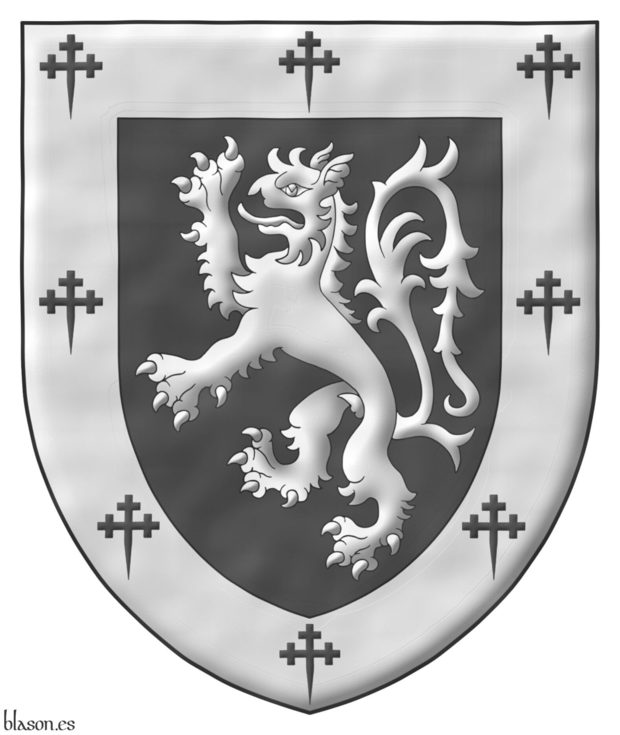
Sable, a tyger rampant Argent; a bordure Argent charged with eight crosses crosslet fitchy Sable.
Escudo de sable, un tigre heráldico rampante de plata; una bordura de plata cargada de ocho cruces recrucetadas, fijadas de sable.
Arms depicted by me, illuminated with lights and shadows, outlined in Sable, with a pointed external shape and with a watercolor finishing.
Coat of arms of the Lord of South Clifton emblazoned by me. In heraldry, there are two types of tigers with specific names in both English and Castilian: the «tyger» in English I call «tigre heráldico» in Castilian, and the «tiger» in English I refer to as «tigre» in Castilian, omitting the Bengal qualifier that some authors use for the natural tiger. According to [Fox-Davies, A. C.; 1909; page 191, figures 322-325], the differences between these two representations are significant. The «tyger», or «tigre heráldico», is a fantastical animal, created from the imagination of medieval artists who were unfamiliar with the real animal but knew of its existence through distant descriptions. This heraldic tyger has a body resembling that of the natural tiger, but with a mane like that of a lion, a tufted tail, and a peculiar head that looks more like a wolf than a natural tiger. Additionally, it lacks the characteristic stripes of the Bengal tiger. Recall that the heraldic panther is also an example of a fantastical animal, breathing fire from its nose and ears and covered in colorful spots. On the other hand, the natural «tiger», identified as the «Bengal tiger» by [Fox-Davies, A. C.; 1909; page 191, figures 324-325], appears in heraldry later and is a more realistic depiction of the animal as it exists in nature.
Blazon keywords: Sable, Argent, One, Eight, Tyger, Rampant, Bordure, Charged and Cross crosslet fitchy.
Style keywords: Outlined in sable, Illuminated, Pointed and Watercolor.
Classification: Personal, Interpreted, Boa and Coat of arms.
Bearer: South Clifton, Lord of.


Lord of South Clifton
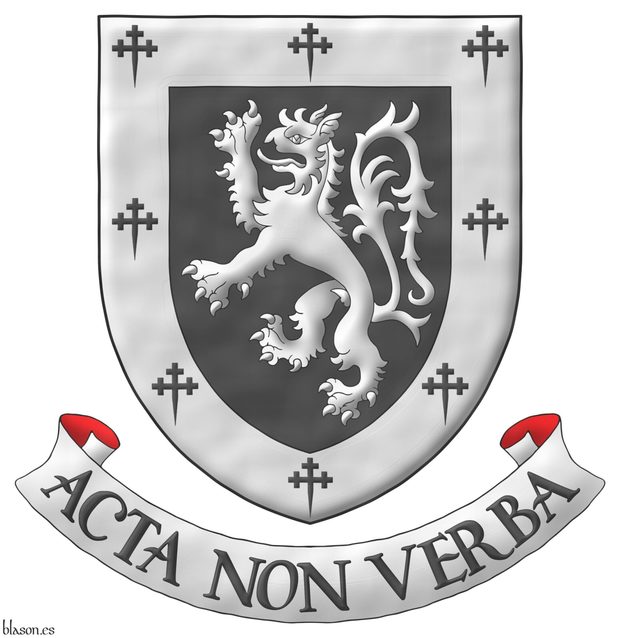
Sable, a tyger rampant Argent; a bordure Argent charged with eight crosses crosslet fitchy Sable. Motto: «Acta Non Verba» over a scroll Argent doubled Gules.
Escudo de sable, un tigre heráldico rampante de plata; una bordura de plata cargada de ocho cruces recrucetadas, fijadas de sable. Lema: «Acta Non Verba» sobre una filacteria de plata doblada de gules.
Coat of arms emblazoned by me, illuminated with lights and shadows, outlined in Sable, with a pointed outer contour and with a watercolor finish.
Coat of arms of the Lord of South Clifton emblazoned by me.
Blazon keywords: Sable, Argent, Gules, One, Eight, Tyger, Rampant, Bordure, Charged, Cross crosslet fitchy, Motto, Scroll and Doubled.
Style keywords: Outlined in sable, Illuminated, Pointed and Watercolor.
Classification: Personal, Interpreted, Boa and Coat of arms.
Bearer: South Clifton, Lord of.


Crest and mantling of the Lord of South Clifton
Sable, a tyger rampant Argent; a bordure Argent charged with eight crosses crosslet fitchy Sable. Crest: Upon a helm affronty lined Gules, issuant from a crown of Knight, a cross patty Gules. Mantling: Sable doubled Argent.
Coat of arms emblazoned by me, illuminated with lights and shadows, contoured in Sable, with a pointed outer contour and with a watercolor finish.
Blazon keywords: Sable, Argent, Gules, One, Eight, Tyger, Rampant, Bordure, Charged, Cross crosslet fitchy, Crest, Upon (wreath), Helm, Affronty, Lined, Issuant, Crown of Knight, Crown, Cross, Patty, Mantling and Doubled.
Style keywords: Outlined in sable, Illuminated, Pointed and Watercolor.
Classification: Personal, Interpreted, Boa and Coat of arms.
Bearer: South Clifton, Lord of.


Crest, mantling and motto of the Lord of South Clifton
Sable, a tyger rampant Argent; a bordure Argent charged with eight crosses crosslet fitchy Sable. Crest: Upon a helm affronty lined Gules, issuant from a crown of Knight, a cross patty Gules. Mantling: Sable doubled Argent. Motto: «Acta Non Verba» over a scroll Argent doubled Gules.
Coat of arms interpreted by me, illuminated with lights and shadows, contoured in Sable, with a pointed outer contour and with a watercolor finishing.
Blazon keywords: Sable, Argent, Gules, One, Eight, Tyger, Rampant, Bordure, Charged, Cross crosslet fitchy, Crest, Upon (wreath), Helm, Affronty, Lined, Issuant, Crown of Knight, Crown, Cross, Patty, Mantling, Motto, Scroll and Doubled.
Style keywords: Outlined in sable, Illuminated, Pointed and Watercolor.
Classification: Personal, Interpreted, Boa and Coat of arms.
Bearer: South Clifton, Lord of.


Lord of South Clifton, hand-drawn
Sable, a tyger rampant Argent; a bordure Argent charged with eight crosses crosslet fitchy Sable.
Coat of arms of the Lord of South Clifton. The image combines a photograph of a drawing of a tyger rampant with the final version of his coat of arms, both created by me. From my original hand-drawn sketch to its final heraldic embodiment, this tyger has lost the stripes on its back because the heraldic tyger should not have them, unlike a natural tiger. The image also shows how the mane evolved from the original hand-drawn sketch to the final heraldic version, ensuring the tyger's mane is distinctly different from a lion's.
Blazon keywords: Sable, Argent, One, Eight, Tyger, Rampant, Bordure, Charged and Cross crosslet fitchy.
Style keywords: Outlined in sable, Illuminated and Pointed.
Classification: Personal, Interpreted, Boa, Hand-drawn, Collage and Photographic.
Bearer: South Clifton, Lord of.


Arrano Beltza, schema 2x3
Or, a eagle displayed Sable.
Coat of arms of the Arrano Beltza, the black eagle, emblazoned by me in 6 steps: 1) Given a rectangle of any proportion, draw its vertical and horizontal axes of symmetry in Azure. Draw a line parallel to the horizontal axis at any distance; in the figure, it is drawn above the axis and in Vert. To achieve this, draw an arc, in gules in the figure, with its center at the point Pcj and of any radius, where Pd is the intersection of the arc with the dexter side and Ps the intersection with the sinister side. The parallel line runs from Pd to Ps. 2) Draw the diagonal in bend of the 3rd quarter, from Pd to Pcp, and the diagonal in bend sinister of the 4th quarter, from Ps to Pcp, both in Gules in the figure. Then draw their two perpendicular bisectors, which will intersect the Pd-Ps line at the points Cs and Cd. 4) With Cd as the center, draw the dexter arc of the base passing through Pd, with a radius of Cd-Pd. Similarly, with Cs as the center, draw the sinister arc of the base passing through Ps, with a radius of Cs-Ps. Both arcs intersect at the point Pcp at the base and are shown in Gules in the figure. 5) Draw in Sable the external shape of the coat of arms, formed by the arcs from Ps to Pcp and Pd to Pcp, the dexter flank from Pd to Pdj at the dexter of the chief, the sinister flank from Ps to Psj at the sinister of the chief, and the upper horizontal line of the chief from Pdj to Psj. 6) Draw an eagle displayed using the rule of plenitude. 7) Finally, paint the field of the shield Or and the eagle Sable.
Blazon keywords: Or, Sable, One, Eagle and Displayed.
Style keywords: Outlined, Outlined in sable, Plain tincture and Semi-circular.
Classification: Civic, Interpreted, Schema, Boa and Coat of arms.
Bearer: Arrano Beltza.

Continue with: Arrano Beltza, plain tincture.
-
Language
-
Categories of heraldry
-
Divisions of the field
- Without divisions
- Party per pale
- Party per fess
- Party per bend
- Party per bend sinister
- Tierce
- Tierce sinister
- Tierced per pale
- Tierced per fess
- Tierced per bend
- Tierced pallwise inverted
- Quarterly
- Quarterly per saltire
- Gyronny
- Party per fess, the chief per pale
- Party per pale, the sinister per fess
- Party per fess, the base per pale
- Party per pale, the dexter per fess
- Chapé
- Chaussé
- Embrassé
- Contre-embrassé
- Party per chevron
- Enté
- Enté en point
- Flanched
-
Metals
-
Colours
-
Furs
-
Other tinctures
-
Ordinaries and sub-ordinaries
-
Diminutives of the ordinaries
-
Geometric charges
-
Composite ordinaries
-
Inanimate charges from Nature
Atom, Crescent, Diamond, Emerald, Estoile, Increscent, Lightning flash, Moon, Mount, Mullet, Mullet of four points, Orbital, Plough of Ursa Major, Rainbow, Ray of the sun, River, Sea, Snowflake, Sun, Sun in splendour, Sun of May, Trimount, Water and Wave.
-
Vegetal charges from Nature
Acorn, Apple, Apple tree, Ash, Bluebonnet, Camellia, Chrysanthemum, Cinquefoil, Cornflower, Dogwood flower, Double rose, Elm, Fleur de lis, Flower, Gourd, Holm oak, Hop cone, Kapok tree, Laurel, Lily, Linden, Lotus flower, Madonna lily, Mexican cedar tree, Oak, Olive tree, Palm tree, Plantain plant, Pomegranate, Poplar leaf, Rose, Shamrock, Sunflower, Thistle, Tree, Tulip, Vine and Wheat.
-
Animal charges from Nature
Badger, Bald eagle, Barbel, Barn owl, Bear, Beaver, Beetle, Bighorn sheep, Blackbird, Boar, Brach hound, Bull, Doe, Dog, Dolphin, Dove, Eagle, Elephant, Falcon, Female figure, Fish, Flame, Fly, Fox, Frog, Goat, Goldfinch, Goose, Heron, Horse, Hummingbird, Jaguar, Lark, Leopard, Lion, Lion passant, Lion rampant guardant, Lioness, Lynx, Male figure, Martlet, Merino ram, Owl, Panther, Parrot, Peacock, Pelican, Pelican in her piety, Puffin, Quetzal, Raven, Roe deer, Rooster, Savage, Seagull, Serpent, She-wolf, Stag, Starling, Talbot, Tyger, Vulture, Warren hound and Wolf.
-
Parts of natural charges
Arm, Beak, Branch, Caboshed, Chest, Claw, Covert, Dorsal fin, Eagle claw, Ermine spot, Escallop, Feather, Foot (palmiped), Foreleg, Forepaw, Hand, Head, Heart, Hoof, Leaf, Neck, Ostrich feather, Palm frond, Paw, Roe deers' attires, Shoulder, Sprig, Stags' attires, Stem, Swallow-tail, Tail, Tail addorsed, Tail fin, Talon, Tooth, Trunk, Trunk (elephant), Two hands clasped, Two wings in vol, Udder, Wheat spike, Wing and Wrist.
-
Artificial charges
Ace of spades, Anchor, Anvil, Arch, Arm vambraced, Armillary sphere, Arrow, Axe, Bell, Bell tower, Beret, Bonfire, Book, Bookmark, Bow, Branding iron, Bridge, Broken, Buckle, Cannon, Cannon dismounted, Cannon port, Canopy roof, Carbuncle, Castle, Celtic Trinity knot, Chain, Chess rooks, Church, Clarion, Clay pot, Closed book, Club, Column, Comb, Compass rose, Conductor's baton, Cord, Covered cup, Crozier, Crucible, Cuffed, Cup, Cyclamor, Dagger, Double vajra, Drum, Ecclesiastical cap, Fanon, Federschwert, Fleam, Four crescents joined millsailwise, Galician granary, Garb, Gauntlet, Geometric solid, Grenade, Halberd, Hammer, Harp, Host, Hourglass, Key, Key ward, Knight, Knot, Lantern, Letter, Line, Loincloth, Menorah, Millrind, Millstone, Millwheel, Monstrance, Mortar, Mullet of six points pierced, Nail, Non-classic artifact, Norman ship, Number, Oar, Oil lamp, Open book, Page, Pair of scales, Parchment, Pestle, Piano, Pilgrim's staff, Plough share, Polish winged hussar, Port, Portcullis, Potent, Quill, Ribbon, Rosette of acanthus leaves, Sabre, Sackbut, Sail, Scroll, Scythe, Sheaf of tobacco, Ship, Skirt, Spear, Spear's head, Stairway, Star of David, Step, Sword, Symbol, Tetrahedron, Torch, Tower, Trident, Trumpet, Turret, Two-handed sword, Wagon-wheel, Water-bouget, Wheel, Winnowing fan and With a turret.
-
Immaterial charges
Angel, Archangel, Basilisk, Dragon, Dragon's head, Garuda, Golden fleece, Griffin, Heart enflamed, Justice, Mermaid, Our Lady of Mercy, Ouroboros, Paschal lamb, Pegasus, Phoenix, Sacred Heart of Jesus, Saint George, Sea-griffin, Trinity, Triton, Unicorn, Winged hand and Wyvern.
-
External elements
-
Heraldic creations
-
References
-
Formats
-
Keywords on this page
Watercolor, Pointed, Arrano Beltza, Boa, Bordure, Charged, Upon (wreath), Crest, Collage, Crown, Crown of Knight, Cross, Cross crosslet fitchy, Affronty, Outlined, Outlined in sable, Displayed, Hand-drawn, Doubled, Doctor, Coat of arms, Schema, Scroll, Lined, Photographic, Personal, Gules, Illuminated, Interpreted, Mantling, Motto, Semi-circular, Eight, Or, Patty, Argent, Civic, Rampant, Sable, Issuant, South Clifton, Lord of, Tyger, Plain tincture, One, Helm and Eagle.

